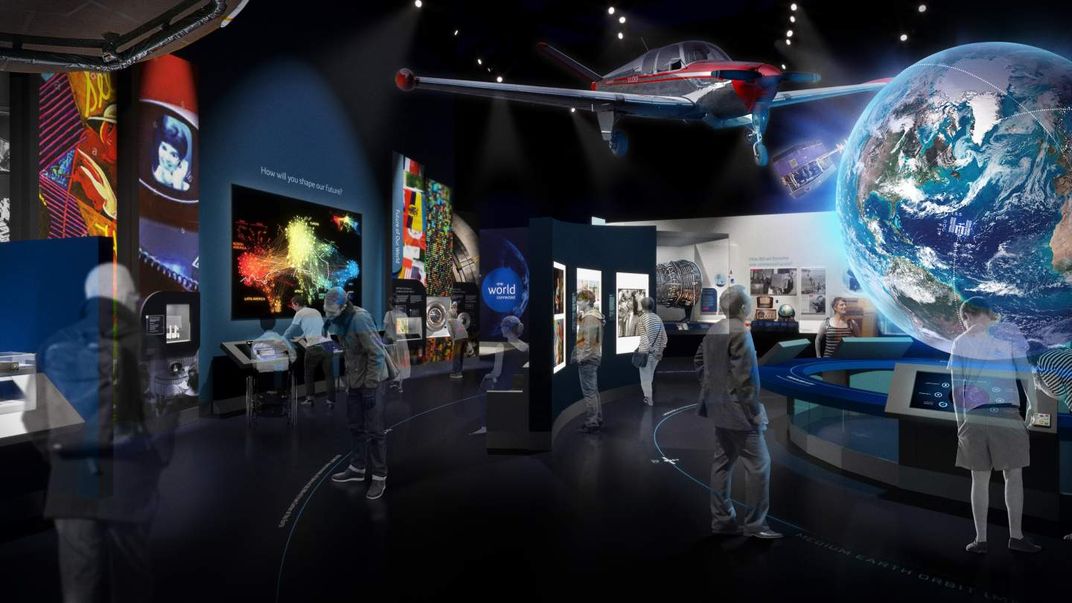National Air and Space Museum Says Pardon Our Renovation, but Come Anyway
In need of a new facade, the museum undergoes top-to-bottom change, bringing state-of-the-art technology and 21st century stories into its exhibitions
/https://tf-cmsv2-smithsonianmag-media.s3.amazonaws.com/filer/2c/67/2c67673a-3d62-4b68-a4c1-2a53c7e2c63f/img_0613.jpg)
In 1976, the Smithsonian’s National Air and Space Museum building opened on the National Mall to much fanfare and celebration, quickly becoming one of the most visited museums in the world. The opening was part of the nation’s bicentennial celebrations, and the construction of the sprawling, blocks-long building was completed on time and on budget. But the cost-saving measures enacted to meet budgetary requirements have not weathered the test of time. In 2011 after a 5.8 magnitude earthquake rocked Washington, D.C., investigators assessing damages found that cracking and warping of the museum’s 1.5-inch-thick walls appeared to have compromised the building’s HVAC system. Covered walkways were put up for fear of falling chunks of marble.
The museum’s new director Ellen Stofan, NASA’s former chief scientist, has noted the much-loved museum was in need of attention. “We’re falling apart,” she told the Washington Post.
In a massive, seven-year project, the entire facade will be replaced, a project that calls for half the museum to be closed at any given time. But visitors will still be able to see parts of the museum's galleries.
Keeping the museum open means the project will take longer, says Elizabeth Wilson, the museum’s assistant director of advancement, despite the inconveniences both visitors and construction workers will experience during the renovation period.
“We’re staying open on purpose,” Wilson says. “This would be easier and cheaper if we shut down and re-did it, but we want to be open for the American people. So, it’s going to be a bit messier. . . but for a lot of people these are once-in-a-lifetime trips, and we want to make sure we can accommodate that.”
Visitors will find sidewalk and street lane closures along Jefferson Drive, Seventh and Fourth Streets and Independence Avenue. Pedestrians will have to cross to the other side of the streets.
In January, gallery closures on the west side of the building, including the exhibitions “America by Air,” “Sea-Air Operations,” “Military Unmanned Aerial Vehicles,” “Golden Age of Flight,” “World War II Aviation,” “Jet Aviation” and “Legend, Memory and the Great War in the Air,” got underway. (The east side exhibitions “Apollo to the Moon” and “Looking at Earth" closed in December.) Guests can still see iconic aircraft, like the Spirit of St. Louis, SpaceShipOne and the Bell X-1 Glamorous Glennis, in the centralized “Boeing Milestones of Flight Hall.” Curators are at work now drafting new shows to debut when the west side reopens in 2022.
Wilson stresses the museum will share as much as they can with the public, despite the monumental logistics of moving around more than 5,000 artifacts during the renovations. Many will be transferred to the Air and Space Museum’s other location, the Steven F. Udvar-Hazy Center, near Dulles Airport in Chantilly, Virginia. There, they will either go on display or undergo restorations in Hazy’s spacious Mary Baker Engen Restoration Center, where the public can watch the work being done from an overhead mezzanine.
Chief curator Peter Jakab says the museum will offer special events and programming this year to celebrate the 50th anniversary of the Apollo 11 lunar landing. In addition to bringing a number of Apollo astronauts to the the museum to tell their stories, significant artifacts and Neil Armstrong’s spacesuit will be pulled from storage.
Incorporating technology into exhibition storytelling is one of the biggest goals in redesigning the galleries, Wilson says. The project aims to be flexible when it comes to technology. Wilson says they’re letting the storytelling choose the technology, not the other way around.
“Our director wants every child who comes into this museum to see themselves throughout the museum,” she says. “[The storytelling should] really focus on who the people are behind these objects and telling really diverse stories: not just the pilot, but who built that airplane and who worked on that assembly line.”

Wilson is excited about the opportunity to “completely reimagine a two-and-a-half-block museum,” especially when it comes to bringing the Apollo exhibitions into the modern era. When the museum opened in 1976, the Apollo program had just ended and was fresh in the minds of visitors. Now, Wilson says, many of the parents bringing their children to the museum weren’t even alive when the lunar landing occurred.
Jakab is looking forward to a new exhibition that will focus on the future of space flight, incorporating artifacts and stories from SpaceX and private space travel that will bring a more “contemporary focus” to the space galleries.
It will be three years before visitors will get to see the first fruits of these labors, and seven years until the final product is unveiled. “When this is all done, we’re going to be reintroducing these American heroes to the country,” Wilson says. “And I don’t just mean Neil Armstrong, I mean everybody who’s pulled off this uniquely American triumph with flight and aviation.”
Check for updates on the renovation, visitor information and see a preview of the new plans on the "Ignite Tomorrow: The Mission to Transform the National Air and Space Museum" website.
/https://tf-cmsv2-smithsonianmag-media.s3.amazonaws.com/accounts/headshot/jane.png)


/https://tf-cmsv2-smithsonianmag-media.s3.amazonaws.com/accounts/headshot/jane.png)